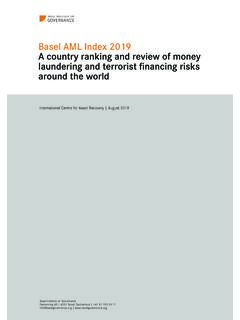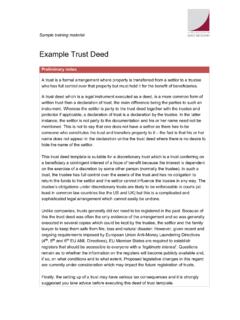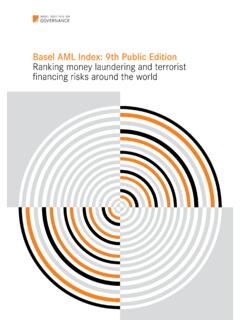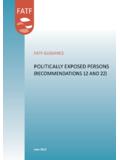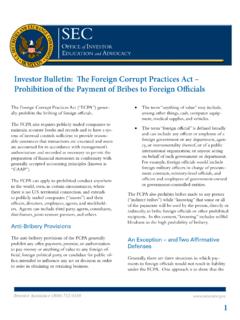Transcription of Basel AML Index 2021: 10th Public Edition Ranking money ...
1 Basel AML Index 2021: 10th Public EditionRanking money laundering and terrorist financing risks around the worldBASEL AML Index 10TH Public Edition 2021 041 INTRODUCTION072 TREND 1: VIRTUAL ASSETS AND money LAUNDERING113 TREND 2: EFFECTIVENESS OF AML / CFT SYSTEMS154 TREND 3: BENEFICIAL OWNERSHIP AS A PILLAR OF EFFECTIVE AML / CFT SYSTEMS215 TREND 4: ML / TF VULNERABILITIES BEYOND THE FINANCIAL SECTOR246 SCORES AND RANKING267 REGIONAL FOCUS438 EXPERT Edition AND EXPERT Edition PLUS459 ABOUT AND CONTACT4610 ANNEX I: METHODOLOGY5011 ANNEX II: JURISDICTIONS NOT INCLUDED DUE TO A LACK OF 4TH-ROUND FATF EVALUATION3 Basel AML Index 10TH Public Edition 2021 Acronyms and abbreviationsAML Anti- money LaunderingAMLD Anti- money Laundering Directive (EU)CDD Customer Due DiligenceCFT Counter Financing of TerrorismDNFBP Designated Non-Financial Businesses and ProfessionalsEU European UnionFATF Financial Action Task ForceIO Immediate Outcome (FATF effectiveness measure)ML / TF money Laundering and Terrorist FinancingR.
2 Recommendation (FATF standard)TCSP Trust and Company Service Provider UAE United Arab EmiratesUS United StatesVASP Virtual Asset Service ProviderWEF World Economic ForumAbout this reportThe Basel AML Index is developed and maintained by the International Centre for Asset Recovery at the Basel Institute on report is licensed under a Creative Commons Attribution-NonCommercial-NoDerivatives International License (CC BY-NC-ND ).Suggested citation: Basel Institute on Governance, 2021. Basel AML Index 2021: 10th Public Edition Ranking money laundering and terrorist financing risks around the world. Available at: we have made reasonable efforts to ensure the accuracy and completeness of information provided in this report, neither the authors nor the Basel Institute on Governance nor our donors and collaborators assume any responsibility or liability for any errors or omissions, or for your use of the information and opinions contained in the report.
3 Please send any feedback to: AML Index 10TH Public Edition 2021 1 Introduction This report accompanies the 10th Public Edition of the Basel AML Index , released in September 2021. The Basel AML Index measures the risk of money laundering and terrorist financing (ML / TF) in jurisdictions around the world. Risk, as measured by the Basel AML Index , is defined as a jurisdiction s vulnerability to ML / TF and its capacities to counter it; it is not intended as a measure of the actual amount of ML / TF activity in a given annually since 2012, the Basel AML Index remains the only independent, research-based Index by a non-profit organisation Ranking jurisdictions according to their risk of ML / Calculating and interpreting risk scoresRisk scores are based on data from publicly available sources such as the Financial Action Task Force (FATF), Transparency International, the World Bank and the World Economic Forum.
4 They cover 17 indicators in five domains relevant to assessing ML / TF risk at the jurisdiction level:1. Quality of AML / CFT Framework2. bribery and Corruption3. Financial Transparency and Standards4. Public Transparency and Accountability5. Legal and Political RisksThe Public Edition of the Basel AML Index reflects the overall score of jurisdictions in terms of their risk exposure to ML / TF. However, and while the Basel AML Index does provide a Ranking in accordance with this score, we strongly advise against a superficial comparison of countries in accordance with their Ranking . Instead, we encourage users to look at regional and global trends, and developments over time, and at what the Basel AML Index says about remaining weaknesses in the global response to ML / TF. We also encourage users to conduct a more in-depth analysis of individual countries or regions or risk factors by using the more comprehensive data that is available in the Expert AML Index 10TH Public Edition 2021 1 AML risk trends in 2021 Crunching data on money laundering risks for the Basel AML Index reveals interesting and often concerning trends.
5 This year, we look at the data behind four topics that are hitting headlines:Virtual assetsThe latest data on how jurisdictions are responding to money laundering threats related to virtual assets. The answer: not well at AML systemsAre jurisdictions more effective at prevention of money laundering or at enforcement?Ineffective systems are the general rule, but jurisdictions consistently score worse for prevention than for ownershipHow slow and ineffective implementation of beneficial ownership registries continues to provide safe havens for dirty money . This is damaging for individual jurisdictions, but more importantly undermines all global efforts to combat money professionsLawyers, accountants, real estate agents and other non-financial businesses and professions continue to underperform on compliance with AML / CFT standards. More supervision is urgently needed to close that concerns are described in the following sections, followed by an analysis of regional risk trends and Methodology and expert reviewThe methodology is described in detail in Annex I, with more information on the underlying indicators available on our website.
6 It is essential to familiarise yourself well with the methodology to ensure that you fully understand what the Basel AML Index can and cannot show. This will ensure that you interpret the results properly and that any action you may take in response to the Ranking is well founded. The method employed by the Basel AML Index to calculate the risk scores is reviewed every year by an independent panel of experts to ensure that the method continues to meet best practice standards, and that the Ranking is accurate, plausible and continues to capture the latest developments in ML / TF the Basel AML Index interactive map and Ranking on our new website at AML Index 10TH Public Edition 2021 1 Public , Expert and Expert Plus editionsPublic Edition The Public Edition of the Basel AML Index 2021, and the analysis in this report, covers 110 jurisdictions. This year, we are including only jurisdictions that have been evaluated using the FATF s fourth-round methodology, in order to provide a reliable basis for comparison.
7 A separate list in Annex II also includes 45 jurisdictions with older FATF evaluations but otherwise sufficient data to calculate a risk score. Expert Edition The Expert Edition , which includes a customisable interactive Ranking , jurisdiction profiles and data downloads, covers 203 jurisdictions. Companies and financial institutions use the Expert Edition for compliance and risk assessment purposes. In the Public sector and academia, the Expert Edition supports AML / CFT research and policymaking. Expert Edition Plus Expert Edition Plus subscribers benefit from an in-depth quantitative and written analysis of FATF reports, plus special reports on money laundering risks in Jersey, Guernsey, Isle of Man, Gibraltar and the Cayman AML Index 10TH Public Edition 2021 2 Trend 1: Virtual assets and money launderingThe latest data on how jurisdictions are responding to money laundering threats related to virtual assets.
8 The answer: not well at money laundering threats from cryptocurrenciesThe use of virtual assets such as cryptocurrencies is exploding for legitimate as well as illicit purposes. In January 2021, there were an estimated 106 million cryptocurrency users globally. Data on how any of these may be using cryptocurrencies for criminal purposes, including to launder stolen money , is however scarce. According to a 2021 report by blockchain analysis firm Chainalysis, of the estimated USD billion in cryptocurrency transactions in 2019, criminal activity represented around percent (USD 450 million).Cryptocurrencies have unique characteristics, many of which are very positive, including for example the potential to improve financial inclusion. Yet their borderless nature and existence outside the formal financial system also make them a tempting option for criminals to conceal proceeds of corruption and other crimes, evade tax or fund 1: Mitigating ML / TF threats from virtual assets FATF Recommendation 15In 2018, in an effort to motivate jurisdictions to take action to prevent virtual assets becoming a threat to global financial stability, the FATF revised its Recommendation 15 on virtual assets and virtual asset service providers (VASPs).
9 Finalised amendments, an Interpretive Note and accompanying Guidance for a Risk-Based Approach to Virtual Assets and Virtual Asset Service Providers followed in 2019. In essence, the revised Recommendation requires among other things: Jurisdiction must apply a risk-based approach to AML / CFT risks associated with virtual assets. VASPs should be licensed/registered, and subject to adequate regulation and supervision. VASPS must conduct customer due diligence on one-off transactions over USD/EUR 1,000, and submit suspicious activity reports where AML Index 10TH Public Edition 2021 2 TREND 1: VIRTUAL ASSETS AND money LAUNDERING VASPs should obtain information about the originator and beneficiary of transfers and make it available to competent authorities (the so-called travel rule).The FATF defines the term virtual asset as any digital representation of value that can be digitally traded, or transferred, and can be used for payment or investment purposes.
10 This does not include digital representations of fiat currencies or other financial assets included elsewhere in its Recommendations. VASPs include natural or legal persons that offer services such as exchanging between virtual assets and fiat currencies, exchanging between different forms of virtual assets, transferring virtual assets, safekeeping or administering virtual assets, or providing other financial services relating to virtual July 2020 and July 2021, the FATF issued the first and second reports on the results of 12-month reviews on the revised How are jurisdictions doing at mitigating their risks of money laundering using virtual assets?It is still early days, as the final version of the revised Recommendation 15 was only issued in June 2019. However, initial signs are not encouraging. Of the 27 jurisdictions assessed or reassessed1 for technical compliance with the new from June 2020 to June 2021, 19 downgraded their scores.
